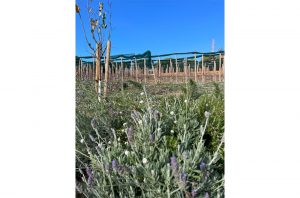François Chartier dedicated his life to the study of wine and food aromas. For over two decades, he has been preaching about his ‘molecular harmony’ theory, arguing that the combination of ingredients that share similar volatile molecules results in enhanced aromatic experiences for the palate. Chartier claims that his studies offer a systematic tool to create superior wine and food pairings, as well as more accurate culinary combinations.
Earlier this month, he unveiled the latest venture born out of his lifelong fascination for aromas. Alongside partner and sommelier Isabelle Moren, he released the preliminary results of his study on ‘botanical biodiversity’, a project based at Chartier’s World Lab in Barcelona that aims to prove how a vineyard’s surrounding flora affects the development of aromas in the finished wine.
‘Both grapes and wines have a propensity to “drink in” their environment, translating it into new aromatic compounds,’ he says. ‘This aromatic metaphor can give you some idea of their power to transmit a “sense of place”. Each vine is imbued with it when it grows in an ecosystem that is rich in… healthy biodiversity.’
Chartier defines his project as the ‘missing link’ in the scientific understanding of terroir. ‘In many years working in wine, I’ve seen people talking of salinity in Manzanilla Sherries, eucalyptus in Barossa reds, or garrigue, aromas that are said to be linked to the vines’ surrounding environment. Basically they’re part of the wine’s terroir, but there’s never been scientific proof of that,’ he says. ‘When you taste a wine from Languedoc or Fitou, you can perceive the garrigue. Not in all wines, but often. And I thought that there must be an explanation.’
The growing academic literature addressing the effect of smoke taint – a result of the increasing threat of wildfires in regions such as parts of Australia and California – offered a convenient scientific groundwork on which to base Chartier’s botanical biodiversity project.
‘I was reading a study on smoke taint in California, British Columbia, and Australia, which explained how and which molecules get into the wine after the wildfires. Now there is scientific proof of how those [volatile compounds] end up in the wine.’
To carry out the project, Chartier put together a wide-ranging scientific team consisting of, among others, scientific director Dr Pere Castells, formerly of culinary research centre Fundación Alicia and scientific advisor at legendary Catalan restaurant El Bulli; Bordelais enologist Dr Pascal Chatonnet; Dr Axel Bidon Chanal, lecturer at the Department of Nutrition, Food Sciences and Gastronomy at the University of Barcelona; and Alba Garcia Martin, PhD candidate in enology, also at the University of Barcelona.

Promising results
Chartier’s botanical harmony project’s preliminary findings were presented to the public at Barcelona Wine Week earlier this month in the form of a ‘manifesto’, a pamphlet currently available in French and Spanish only but soon due to be released in English.
The publication features the project’s scientific basis, a definition of Chartier’s molecular harmony theory, and an explanation of how this informed the development of the current investigation. It also reports the outcomes of the project’s preliminary studies, carried out in partnership with the University of Barcelona’s Campus d’Alimentació de Torribera on wines from the Alella DO – near the Catalan capital – and the Hérault region in France.
The researchers first analysed the wines’ aromatic profiles through gas chromatography mass spectrometry (GC/MS), a technique that allows to separate, identify, and quantify complex mixtures of chemicals. These profiles were then compared with those of the surrounding flora, with promising results that Chartier says motivated the team to collect further evidence.
‘This manifesto is just the first step in our journey to understanding how different ecosystems affect terroir,’ says Chartier, explaining that future research will adopt a holistic approach, as it will also involve looking at aromas present in the vineyard’s air, on the vines, on the grapes, and in the soil.
The project is going to broaden its geographical reach, too. A new Chartier World Lab is due to open in Portugal, where the team will be partnering with leading wineries such as Symington and Niepoort, and with the The University of Trás-os-Montes and Alto Douro (UTAD). Further sites will be opening in Japan, where Chartier himself is due to begin a guest professorship at Tokyo’s University of Agriculture this coming autumn; and in Montreal, in Chartier’s home country, Canada.
‘We want to try to demonstrate what’s never been demonstrated scientifically, to give people new tools to describe a wine’s sense of place,’ says Chartier. ‘Biodiversity helps people understand the identity of their own product… whether it’s wine, honey or ham. And by demonstrating the impact of botanical biodiversity on wine’s aromatic identity – its terroir – vineyards’ nature and biodiversity will acquire greater importance and the environment will be better protected.’






